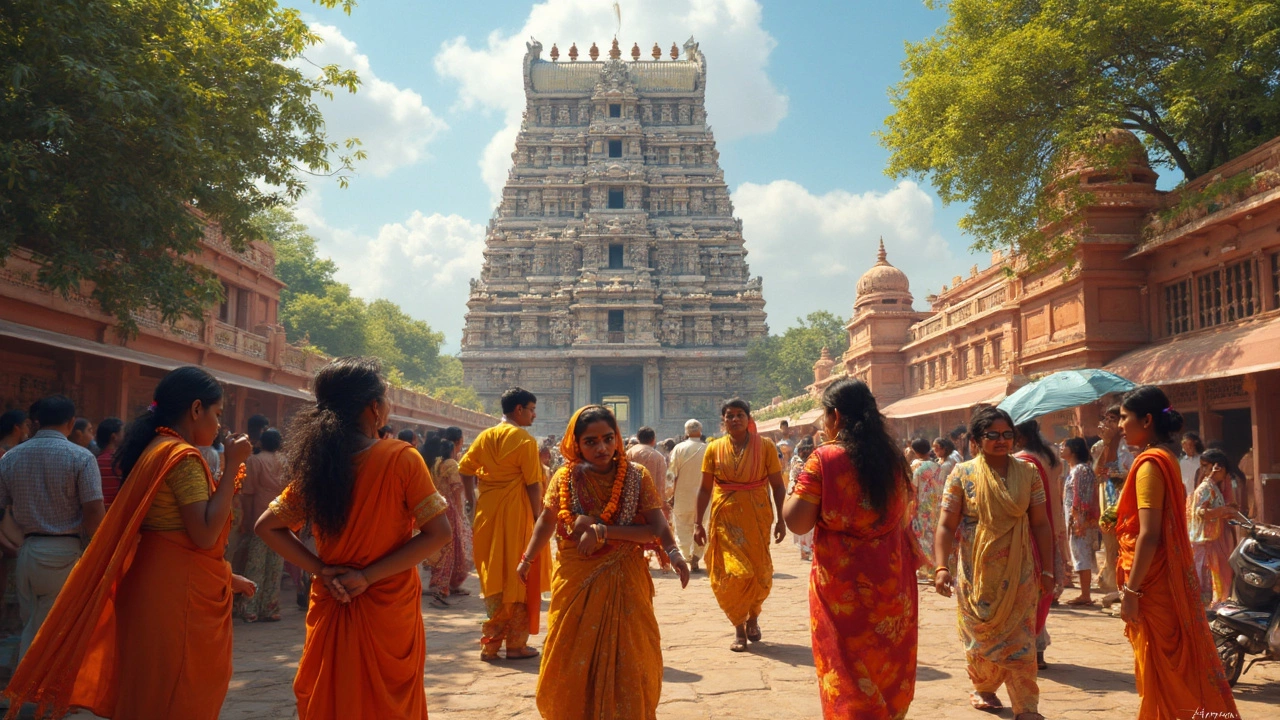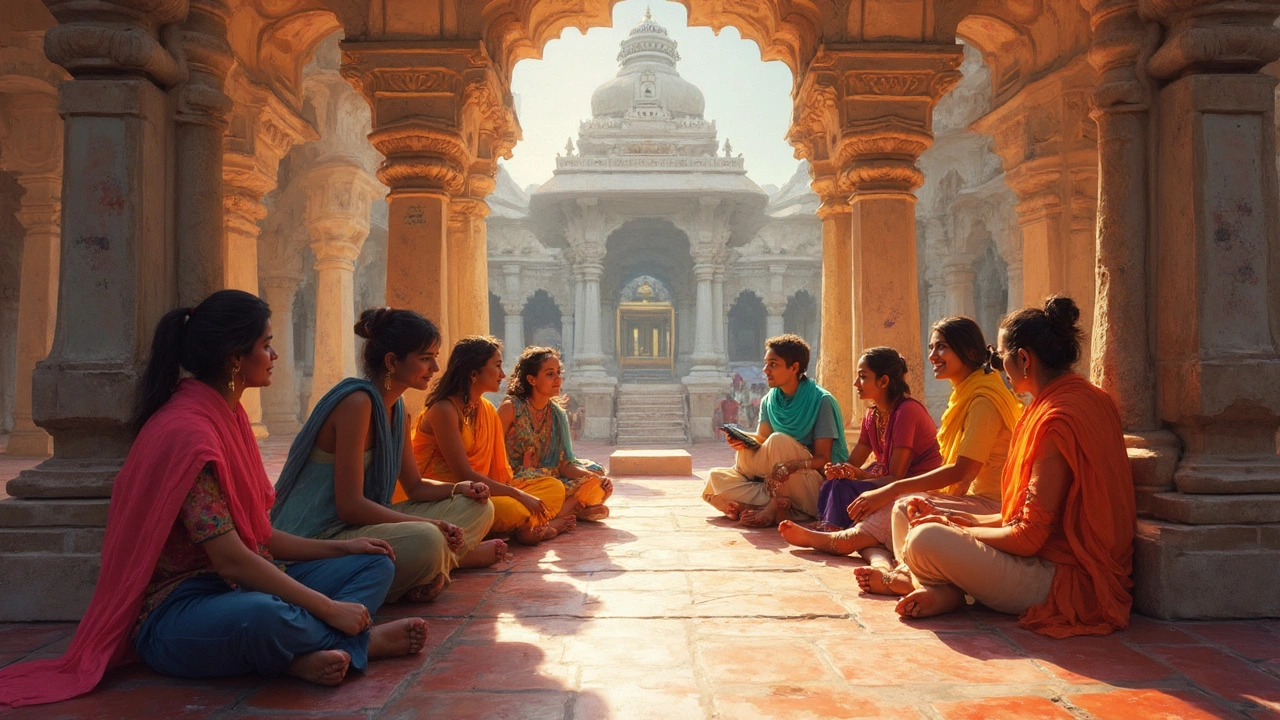Can I Wear Jeans to a Hindu Temple? Dress Code Answers for India Temple Tours
 Apr, 17 2025
Apr, 17 2025
It usually hits you at the worst time—standing outside a gorgeous temple, shoes already off, wondering if you're about to break some unspoken rule. The big question: are jeans okay, or will everyone inside stare at you like you've shown up in a swimming suit?
You’re not alone—almost anyone planning a temple tour in India wrestles with the same thing. Temple dress codes aren't just about tradition, they're about showing respect. Still, every temple does things a bit differently. Some are strict, some are chill. And when it comes to jeans, the answer isn't as cut-and-dry as you might hope.
If you're looking to fit in, feel comfortable, and enjoy the amazing atmosphere instead of stressing about your outfit the whole time, keep reading—I’ll lay it all out for you without any fluff.
- Why Do Temples Have Dress Codes?
- Are Jeans Accepted in Indian Temples?
- Smart Outfit Ideas for Temple Visits
- Quick Tips for Feeling Comfortable and Respectful
Why Do Temples Have Dress Codes?
So why all the fuss about what you wear in a Hindu temple? It’s not random. Hindu temples see themselves as special places—the heart of community life, a spot for spiritual focus, and sometimes, a full-on tourist magnet. The idea behind the Hindu temple dress code is to show respect, both to the deities and to other people visiting.
Most temples believe that the outside—your clothes, your shoes, even how tidy you look—reflects your attitude inside. Wearing clothes that cover shoulders, knees, and sometimes heads is a way to hit pause on your usual routine and set a respectful tone. Jeans can feel too casual for some temples, kind of like turning up to a family wedding in gym shorts.
There’s a practical side too. Many temples in India are centuries old. Outfits like shorts, tank tops, or even tight jeans can be seen as distracting, or even disrespectful by locals and regular worshippers. At a few famous spots like the Meenakshi Temple in Madurai or Padmanabhaswamy Temple in Kerala, people in jeans are flat-out turned away by security at the door. These rules aren’t random—they’re about protecting tradition and making sure everyone’s on the same page.
| Temple | Region | Strict Dress Code? |
|---|---|---|
| Padmanabhaswamy | Kerala | Yes (No pants or jeans allowed) |
| Golden Temple | Punjab | Yes (Head must be covered) |
| ISKCON Temple | Bangalore | Moderate (Decent attire required) |
Not every temple is super strict, though. Small neighborhood temples might just want you to wear clean, tidy, and modest clothes—no need for anything fancy, just don't show too much skin or swagger in straight from a party. The main thing is to always check before you go.
Are Jeans Accepted in Indian Temples?
This question stumps a lot of travelers, and the answer is a mix of yes, no, and "it depends." There isn’t one rule for every Hindu temple dress code in India. Some are pretty relaxed about what you wear, especially in bigger cities or at tourist spots. You’ll see younger locals and even some devotees wearing jeans at popular temples in Delhi, Mumbai, or Bangalore.
Still, plenty of temples are sticklers for tradition. Famous sites like the Meenakshi Temple in Madurai, Guruvayur Temple in Kerala, and the Sri Venkateswara Temple in Tirupati often ban jeans—especially for men. In fact, some of these places won’t let you through the door unless you’re wearing more traditional clothes like a dhoti (for men) or sari/salwar kameez (for women). At the Golden Temple in Amritsar, while jeans aren’t banned, they strongly encourage modest, loose-fitting clothes and covering your head.
There are even a few spots where they post signs at the entrance about what’s okay and what isn’t. Here’s a quick, real-world cheat sheet:
- Big city temples: Jeans often allowed, but keep them clean and not ripped.
- World-famous or historic temples: Jeans might get you turned away, especially if they look casual.
- Rural or traditional temples: Expect stricter rules—jeans usually not accepted.
To give you a feel for the difference, here’s a look at some well-known temple rules in India:
| Temple | Jeans Allowed? | Notes |
|---|---|---|
| Meenakshi Temple (Madurai) | No | Strict on traditional Indian dress, enforced at the entrance |
| ISKCON Temple (Bangalore) | Yes | Jeans usually fine if modest |
| Sri Venkateswara (Tirupati) | No | Traditional dress required, especially for special rituals |
| Golden Temple (Amritsar) | Technically yes | Must cover arms and legs, head covering required |
Bottom line: if you really want to play it safe, go with loose, modest clothes instead of jeans. But if you’re headed to a city temple that welcomes tourists, modest jeans—meaning not too tight, no holes—will often be totally fine. When in doubt, check the temple’s website or ask your hotel. Even locals do the same.

Smart Outfit Ideas for Temple Visits
If you want to make your temple tour India easy and stress-free, what you choose to wear really matters. Jeans feel like a safe bet, but it depends where you’re headed. Some big temples—think the Golden Temple in Amritsar or Meenakshi Temple in Madurai—flat-out say no to jeans or any tight Western clothes. On the flip side, smaller or urban temples can be more relaxed and you might spot regulars in jeans, t-shirts, or long skirts. But honestly, going for simple, modest clothing always works best.
For both men and women, cover your shoulders, knees, and avoid anything clingy. Earthy colors or pastels blend in perfectly, while flashy logos and bright patterns can look out of place. If you're not sure what you'll run into, layering is your friend. Toss a lightweight scarf or shawl in your bag—it's a lifesaver if you need to quickly cover your head or shoulders (some temples ask for this, especially famous ones in South India).
- Men: Plain trousers or loose-fitting chinos, simple collared shirts, and a scarf if needed. A dhoti or lungi is even better if you want to do as the locals do—many temples let you rent these at the entrance.
- Women: Long skirts, loose pants, or traditional salwar kameez (a tunic with pants and a scarf) nail the Hindu temple dress code. Maxi dresses with a scarf work in a pinch, as long as your cleavage, arms, and knees are covered.
- Skip shorts, tank tops, and body-hugging jeans—these just stand out for the wrong reasons, and you might even be turned away at some big temples.
- Bring socks! Remember, shoes are never allowed past the entrance, and temple courtyards can get crazy-hot in the middle of the day.
Check out this table for a quick guide on what flies and what doesn't at most major temples in India:
| Clothing Item | Usually Allowed? | Good Alternative |
|---|---|---|
| Skinny jeans | No | Loose trousers, wide jeans |
| Shorts | No | Light cotton pants |
| T-shirts | Depends | Collared shirt or tunic |
| Skirts (below knee) | Yes | Salwar or maxi skirt |
| Shoes | No (inside) | Socks (bring your own) |
| Head covering | Sometimes required | Scarf or dupatta |
The bottom line for your jeans in temples question: if they're loose, plain, and not ripped or trendy, they might be okay at smaller temples. But play it safe at the famous ones—lean traditional, and you’ll have zero hassles. Your comfort and respect will speak for you.
Quick Tips for Feeling Comfortable and Respectful
No one wants to feel out of place or disrespect traditions while exploring a temple tour in India. Here's what actually helps, so you can focus on the experience instead of worrying about your clothes.
- Always carry a scarf or shawl. Guys and girls—having one is a hack. Temples might ask you to cover your shoulders or even your head. A light scarf hardly takes any space but can save you from awkward moments. Plus, they offer them for rent at big temples, but the ones provided aren't always the cleanest.
- Pack loose and light. India gets seriously hot, and most Hindu temple dress codes say no to tight or revealing clothes. Grab some cotton pants or long skirts. Linen is great too because it breathes in the heat. Strict temples might turn you away if they think your jeans look too casual or are ripped up.
- Double-check temple websites or signs. Some high-profile temples—like Tirupati or Meenakshi—have their rules posted in English. You'll usually see notices right at the entrance. When in doubt, ask a local or your guide before you go in.
- Mind your footwear. You're taking off your shoes at every temple, no exceptions. Sometimes socks have to come off too. If you're grossed out by dirty temple floors, a pair of slip-on shoes and an extra pair of socks in your bag will be a lifesaver.
- Respect queues and rituals. You'll spot signs asking visitors to stay quiet or keep to the right in certain parts. Watch what the locals do—if everyone's sitting down, don’t be the only one standing up snapping photos.
| Temple Name | Dress Code? | Can You Wear Jeans? |
|---|---|---|
| Golden Temple (Amritsar) | Head covered, arms/legs covered | Yes, if not ripped, but traditional wear is better |
| Meenakshi Temple (Madurai) | Traditional clothes only | No—jeans usually NOT allowed |
| ISKCON Temples | Modest dress required | Yes, for both men and women, if not tight |
If you're ever unsure, just go a bit more traditional—nobody ever got turned away for being too respectful. Remember, a temple tour in India is about blending in, not making a statement. Plan with these tips, and you’ll enjoy your trip without any fashion accidents or disrespecting customs.